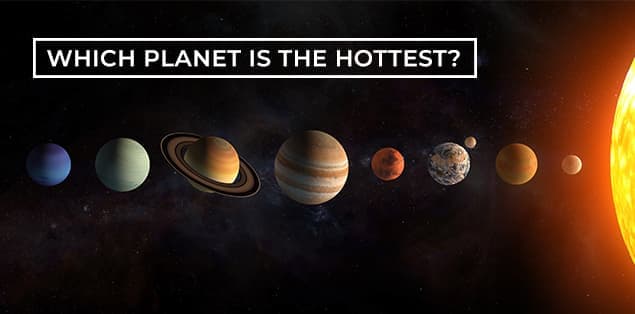So, which planet is the hottest? While the solar system’s giant planets’ cores may receive a considerable amount of energy via radioactivity and gravitational contraction, their surface temperature is primarily determined by the light and heat given by the Sun.
All the planets, including Earth, are kept at an approximate temperature, a few Kelvin over what they would be without the Sun. Most planetary temperatures would equilibrate at -270 °C / -455 °F without an external heat source.
The planets take energy from the Sun during the day and radiate it back into the space at night. That’s why temperatures rise during the day and fall at night.
However, if a planet’s orbital characteristics were the only factors affecting temperature, then the planet closest to the Sun would undoubtedly be the hottest.
Unexpectedly, Mercury isn’t the Sun’s hottest planet.
Mercury “only” reaches 800 °F at its warmest, despite being the planet closest to the Sun, whereas even at night, Venus is hotter than Mercury.
Now, you’re probably wondering why Venus, which is not as close to the Sun as Mercury is, would be hotter than Mercury. So let’s investigate the cause!
Which Is the Hottest Planet in the Solar System?
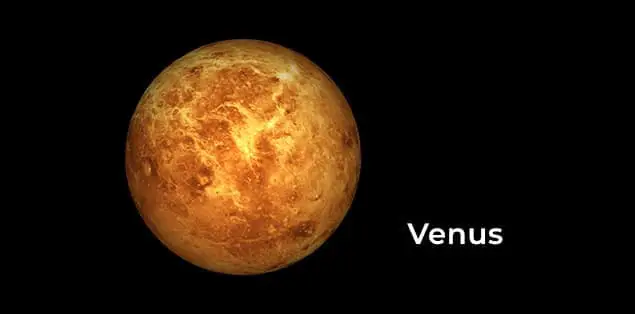
On average, Venus is about 67 million miles from the Sun, i.e., 108 million kilometers. When viewed from Earth, Venus is the brightest planet in the sky and the hottest planet in the solar system.
This scorching planet is the only planet with a female eponym; it is named for the Roman goddess of love and beauty. Since Venus was the brightest of the five planets known to ancient astronomers, it is possible that it was named after the most attractive deity in the pantheon.
Why Is Venus Hotter Than Mercury?
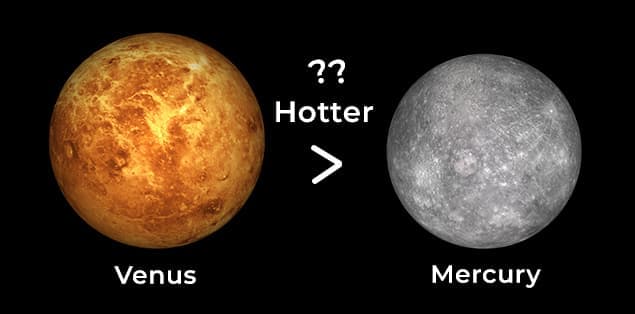
It’s scorching on Mercury. In terms of temperature, it’s scorching! The hottest parts of the planet, which are the nearest to the Sun, reach maximum daytime temperatures of 700 Kelvin (427 °C/800 °F) at their equatorial positions. It completes an orbit in just 88 Earth days. Because Mercury rotates slowly, its night side is shaded from the Sun for extended periods, allowing it to drop to just 100 Kelvin (or 173 °C or 280 °F). It is significantly colder than any known naturally occurring temperature on Earth to have such a low temperature. That is the history of Mercury, the planet nearest to the Sun.
Venus takes around 225 Earth days to orbit the Sun, which is about twice as long as Mercury’s orbital period. Additionally, it rotates more slowly than Mercury, allowing it to experience equal amounts of darkness and sunlight for more than 100 consecutive Earth days at a period. But there’s a surprise when you measure the temperature of Venus: It’s always the same temperature, day or night, at 735 Kelvin (462 °C / 863 °F), making Venus much hotter than Mercury; the solar system’s hottest planet.
When astronomers first noticed this bizarre event, it shocked them more than just confused them. Even if Venus couldn’t produce enough heat on its own, it was hotter at Venusian midnight than at Mercurian high noon. Comparing the two innermost planets was the first step because this observation needs an explanation.
Four Glaring Discrepancies Can be Seen When Contrasting These Two Planets:
1) Mercury and Venus differ significantly; Mercury is much smaller than Venus.
2) Proximity to the Sun.
3) Reflective nature.
4) Venus has a highly dense atmosphere compared to Mercury, which has none.
In absorbing heat, size doesn’t play a more significant role. Therefore the first point is invalid. The second point suggests the Sun’s proximity, But it shows the opposite result as being far from the Sun. Venus should be colder than Mercury, but it’s not the case. The third and fourth point speaks about the reflectivity of a planet and, most importantly, the planet’s atmosphere.
Despite not being the sun-closest planet, Venus has the highest surface temperature in the solar system. Why? Because the atmosphere or layer of gas surrounding Venus is quite thick, heat is trapped on the planet by this dense atmosphere, which prevents it from escaping back into space. The “greenhouse effect” results from this process, which causes Venus to have a hotter surface than Mercury and all other planets combined.
What Is the Temperature on Venus?
A carbon dioxide-based atmosphere that is dense and heavy, surrounds Venus. The planet is also covered in giant clouds of Sulphuric acid. Venus is kept warm by the gases and clouds that trap heat. Near Venus’ surface, the temperature is roughly 867° F (464° C). The lead will melt at this temperature. Additionally, the dense and thick atmosphere results in extremely high pressure. Venus has 92 times the pressure of Earth, which is enough to smash many objects.
According to scientists, Venus’ atmosphere may have resembled Earth’s billions of years ago. Venus’s surface may have contained a significant amount of water as well. However, after many billions of years, water evaporation produced a greenhouse effect, filling its atmosphere with many greenhouse gases.
Which Is the Coldest Planet in the Solar System?
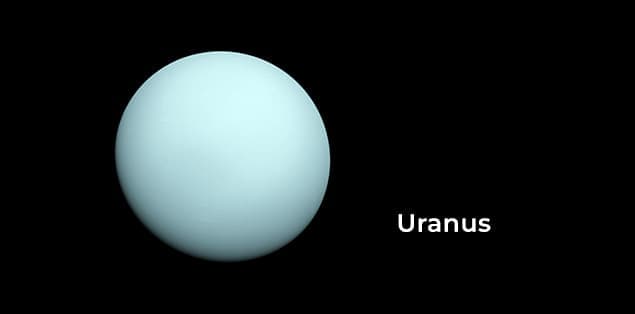
Uranus, which is located in our solar system and is only 20 times further from the Sun than Earth, has the record for being the coldest planet in our solar system. There were 224 degrees below zero reported as the lowest temperature.
Neptune is not the Solar System’s coldest planet; you might assume it to be the coldest, given its distance from the Sun. Amazingly, Neptune is three billion kilometers from the Sun.
Despite being one billion miles closer to the Sun than Neptune, Uranus is the coldest planet, not Neptune. The solar system’s coldest temperature ever recorded is on Uranus, when it was a very frigid -224°C. Neptune’s average temperature of -214°C is still shallow, but Uranus is colder.
Which Planet Is Hotter Than the Earth?
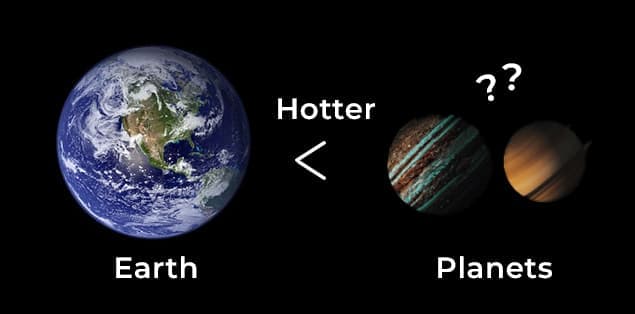
Many thermometers and satellites can measure the temperature here on Earth. Earth’s temperature ranges from 14 to 16 degrees Celsius on average, but it may also reach extremes of -89.3 and 56.7 degrees Celsius in Antarctica and Death Valley, USA, respectively. The varying seasons we experience on Earth are to blame for the wide temperature variations. The eccentric orbit of Earth around the Sun and Earth’s tilt is what causes the seasons. Earth’s atmosphere traps the heat that the Sun gives off.
Since we don’t have as many tools and thermometers to test the temperature on other planets, we make an educated guess as to what it might be. Numerous aspects need to be taken into accounts, such as the planet’s atmosphere and distance from the Sun. Although we have deployed spacecraft to most planets to collect data, we still don’t fully comprehend how these planets’ temperatures vary.
When Mercury, the first planet from the Sun, shifts from day to night, its temperature changes dramatically. The planet can go up to 430°C while being incredibly close to the Sun during the day. However, because Mercury lacks an atmosphere, as it spins to the nightside, this heat escapes into space because there is nothing to trap it, indicating that a temperature drop of up to -180°C is possible.
Venus comes next, with its extremely dense atmosphere of several substances that give it golden clouds. It has a potent greenhouse effect, much like what we see here on Earth. Venus is the hottest planet in the solar system due to this. Venus’s surface is about 465 degrees Celsius!
Venus is hotter than Earth due to its proximity to the Sun. On Venus, the temperature is above 460 °C, compared to the Earth’s average of 14 °C.
Final Words – Which Planet is the Hottest?
Scientific evidence suggests that Venus is not nearly as habitable, despite being more comparable to Earth than any other planet in our solar system. It was done using the most trustworthy information available.
Due to various factors, including its atmosphere composition and prolonged rotation, Venus is the hottest planet in our solar system. It features a solid, stony surface with numerous (perhaps active) volcanoes, asteroids impact craters, vast plateaus, and cloud-covered mountain ranges. Its scientific term is Earth’s “toxic twin,” according to scientists.
Venus could have been a habitable planet for millions of years, but due to its remote location from the circumstellar habitable zone, Venus is now a scorching and toxic planet.
